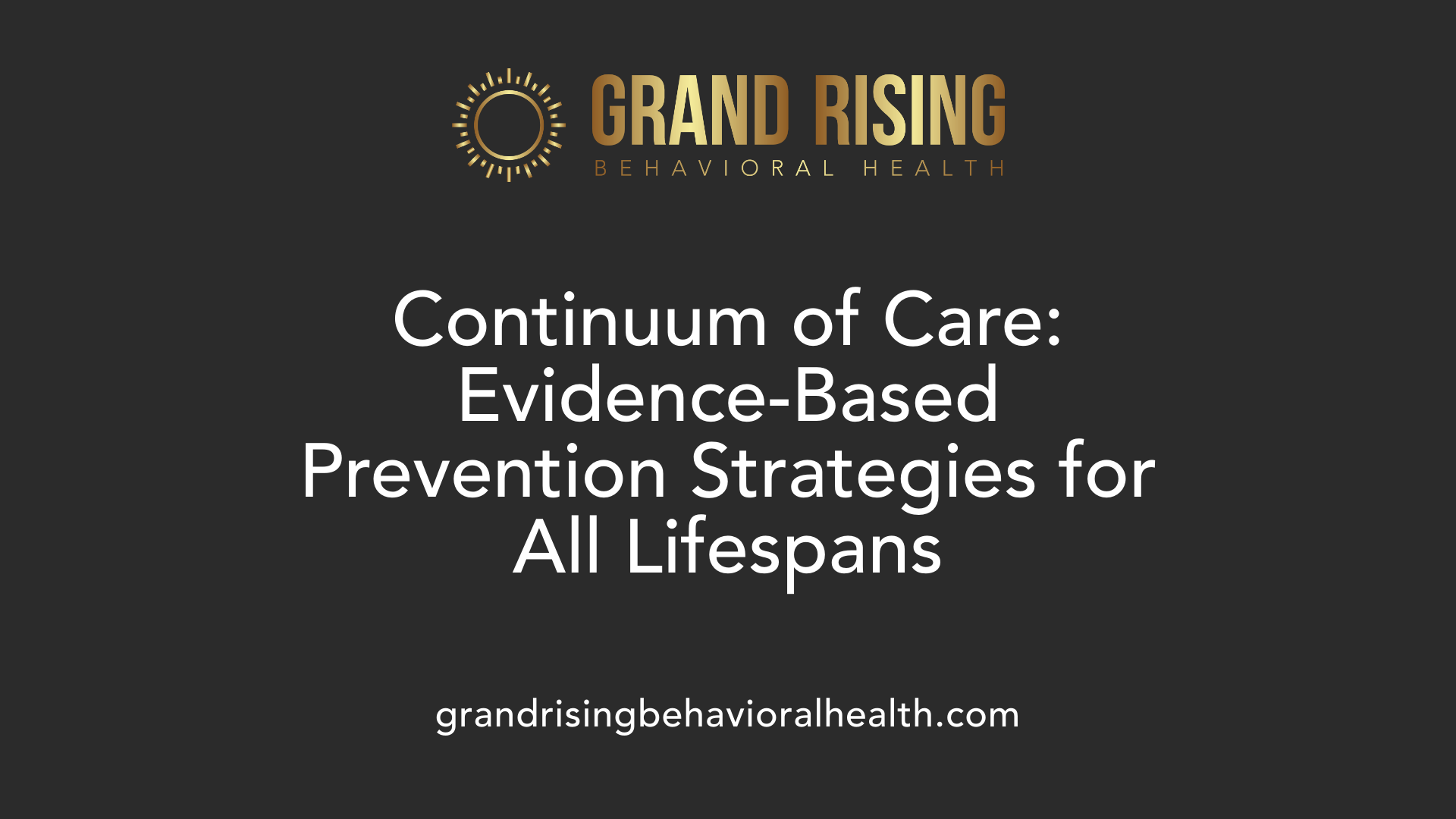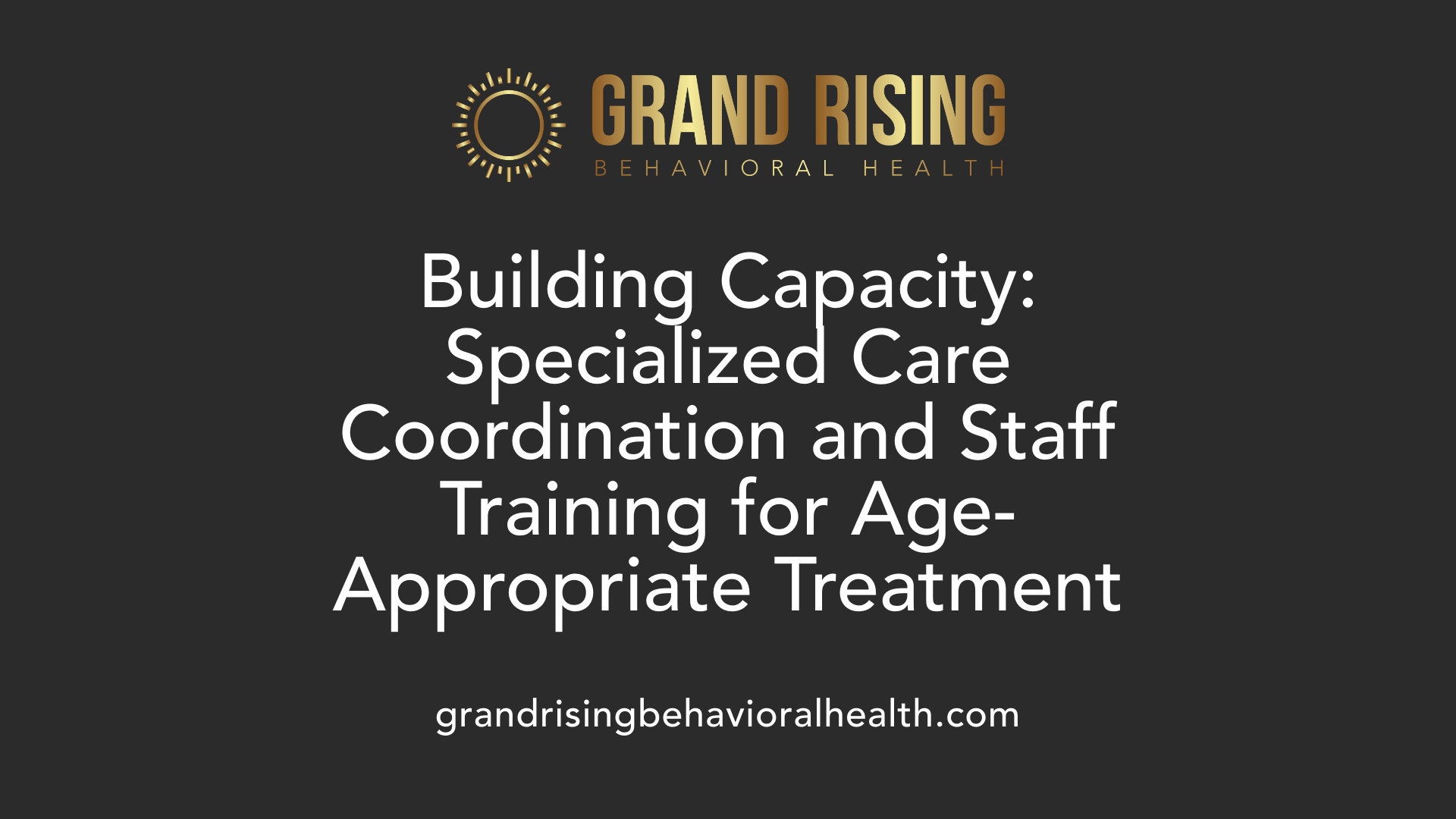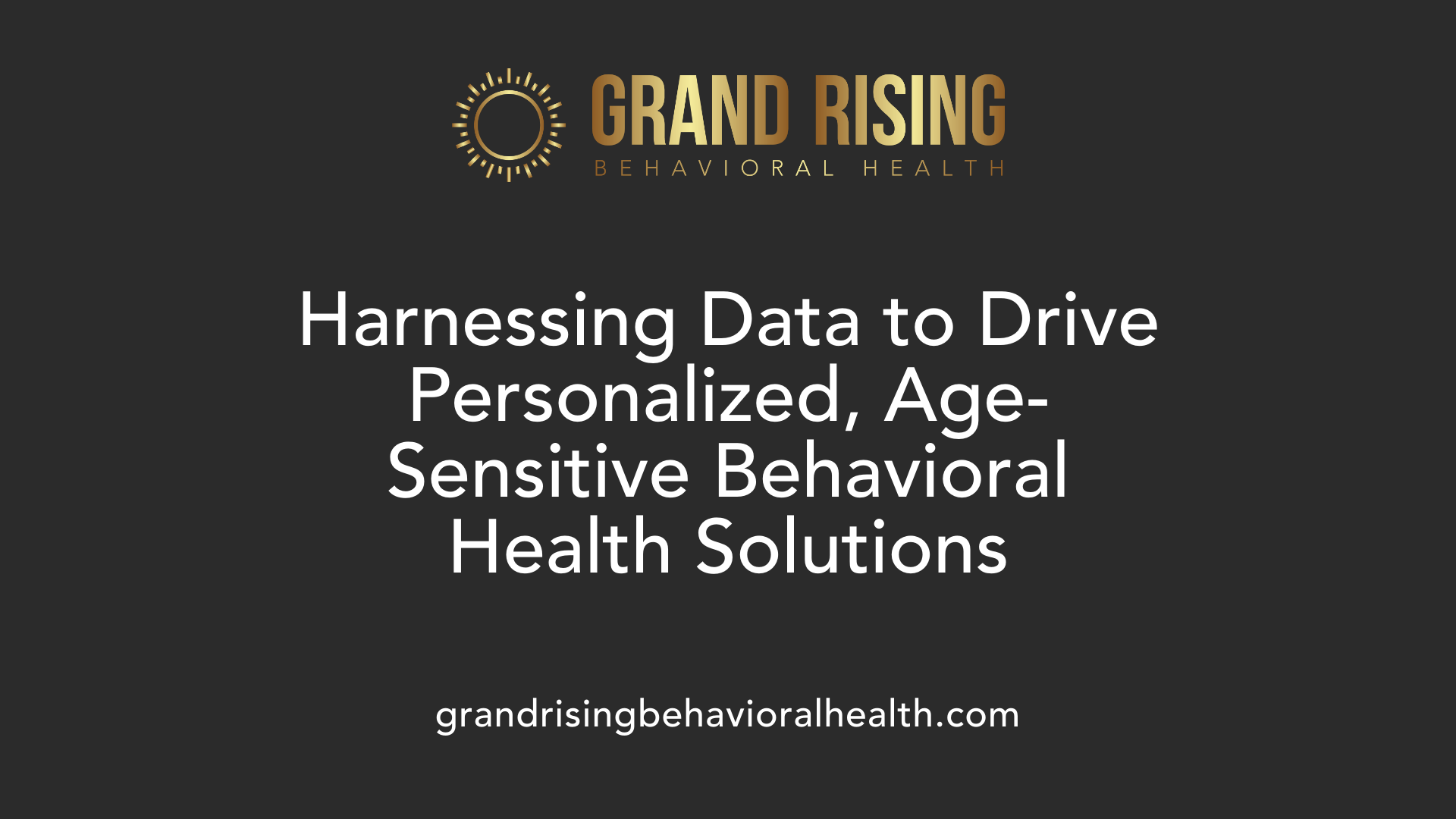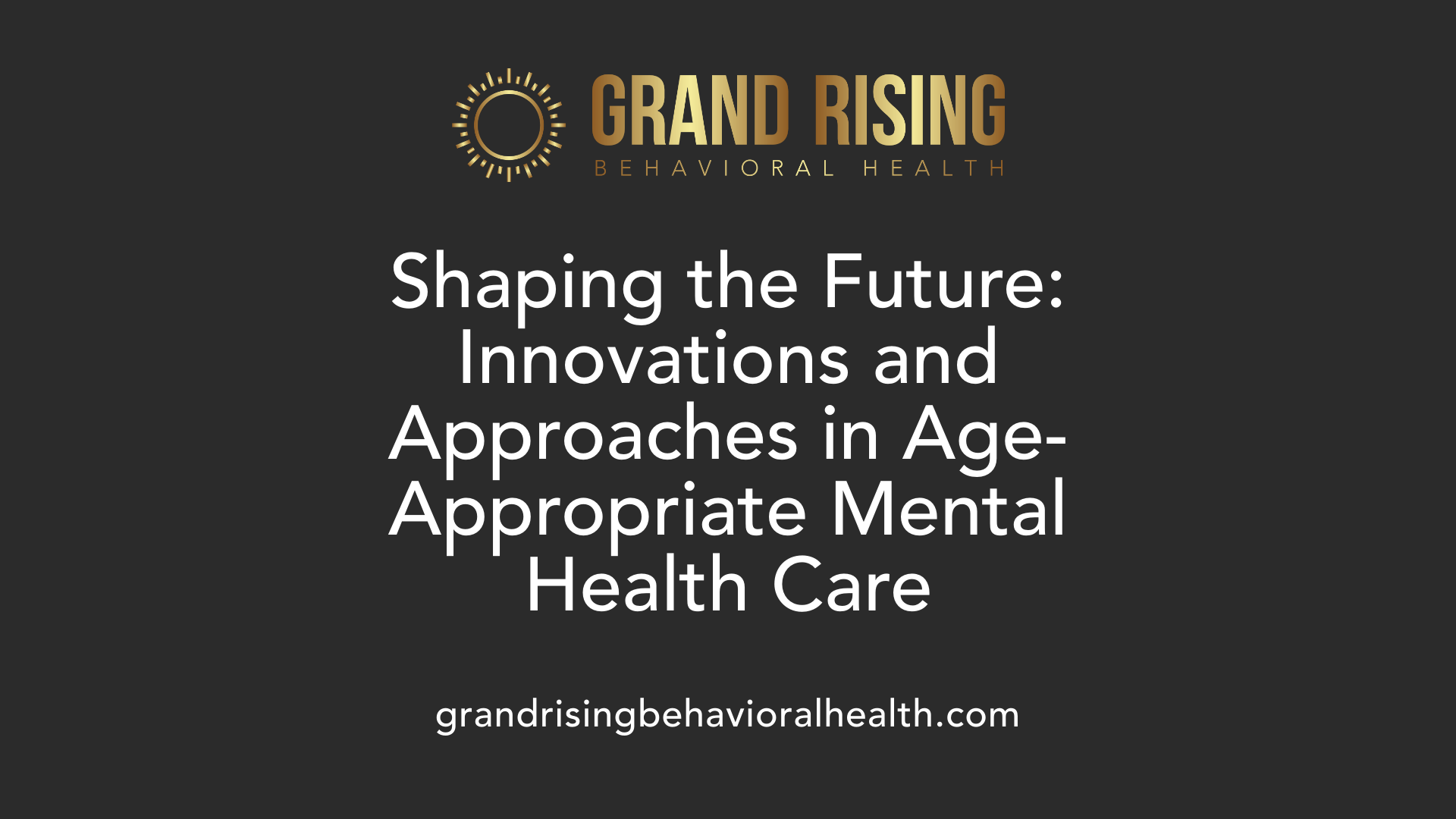How Grand Rising Behavioral Health tailors care for different age groups
Customized Approaches in Mental Health Care for Every Life Stage

Understanding Age-Specific Behavioral Health Interventions at Grand Rising
Grand Rising Behavioral Health exemplifies a comprehensive, age-sensitive approach to mental health treatment. By tailoring services to meet the unique developmental, emotional, and social needs of patients across all stages of life, it ensures effective, personalized care. This article explores how the center customizes its approach for children, teens, adults, and older adults, highlighting the underlying strategies and considerations that inform their practice.
Age-Appropriate Treatment Strategies
How does behavioral health care tailor services for different age groups?
Behavioral health care is designed to meet the unique needs of children, teenagers, adults, and seniors by considering their distinct developmental stages, cognitive abilities, and emotional requirements. This tailored approach ensures that treatments are both effective and relevant to each individual's life circumstances.
For children, interventions often include play-based techniques that make therapy engaging and accessible. These methods help young clients express themselves and develop coping skills in a non-threatening way. Family involvement is also a critical aspect of pediatric care, with therapists working closely with parents or guardians to reinforce skills and support the child's environment.
Teenagers are typically engaged with strategies that address more complex emotional and cognitive processes. Techniques such as thought records, mindfulness, and relaxation exercises are common. Therapy with teens often emphasizes self-exploration, identity development, and peer relationship management, which are vital during this developmental stage.
In adult and older adult populations, therapy is customized to address specific life circumstances. For example, adults may work through stress management, workplace issues, or family dynamics, while seniors might focus on coping with health changes, loss, or isolation. Treatment plans are often adapted to fit individual preferences and cultural backgrounds, incorporating practical homework and activities that align with their motivation and environment.
Therapists modify intervention difficulty and provide alternative activities to maximize engagement and comfort. Creating a safe, respectful space is essential across all age groups, fostering trust and open communication.
Additionally, systemic and cultural factors are integrated into care through approaches like community engagement and empirical evaluation. These efforts ensure that interventions remain relevant and effective for diverse populations.
Age-specific Challenges and Tailored Approaches
| Age Group | Typical Challenges | Tailored Treatment Approaches | Examples |
|---|---|---|---|
| Children | Separation anxiety, behavioral issues | Play therapy, family involvement, skill-building activities | Puppet therapy, parent training sessions |
| Teens | Identity, peer pressure, mood swings | Thought records, mindfulness, social skills training | Discovering coping strategies for peer stress |
| Adults | Work stress, relationship issues | CBT, stress reduction, problem-solving | Workplace counseling, couples therapy |
| Seniors | Aging, loss, health concerns | Support groups, reminiscence therapy, behavioral activation | Memory-focused interventions, social engagement programs |
Life-Stage Specific Mental Health Challenges
Understanding the challenges faced at each life stage allows for more precise and compassionate care. For example, children dealing with separation anxiety benefit from family-based interventions, while seniors facing health-related losses may require grief counseling and social support.
In summary, behavioral health services are carefully adapted to align with each age group’s developmental needs, emotional states, and social contexts. This approach enhances engagement, efficacy, and overall well-being across the lifespan.
Different Developmental Needs and Considerations
What factors are contributing to the growth of behavioral health services?
The expansion of behavioral health services is fueled by several significant factors. Firstly, there is a rising prevalence of mental health and substance use disorders across populations. The COVID-19 pandemic heightened awareness of mental health issues, emphasizing the social and psychological toll it had on individuals worldwide.
Supportive government initiatives and policies have also played a role, reducing stigma and encouraging acceptance of seeking mental health care. Advances in technology, especially telehealth and digital mental health solutions, have made treatment more accessible, especially for underserved or remote areas.
Healthcare organizations increasingly adopt integrated care models, promoting comprehensive approaches that consider social, economic, and medical factors influencing mental health. Demographic shifts, such as increasing mental health needs among youth, concerns surrounding maternal health, and the impact of the opioid crisis, continue to drive the expansion of these services.
Market growth projections indicate a steady increase in demand, prompting investments from healthcare providers and policymakers. Overall, these factors underscore a commitment worldwide to improve mental health support and address the growing needs across all age groups.
What are some common behavioral health conditions across age groups?
Behavioral health conditions are diverse and affect individuals throughout their life span. Across all age groups, common issues include depression, anxiety disorders, attention deficit hyperactivity disorder (ADHD), and substance use disorder.
In children, behavioral and emotional disorders such as oppositional defiant disorder and conduct disorder are frequent, impacting social and developmental progress. Adolescents and adults often face mood disorders like bipolar disorder, which involve significant variations in mood and energy levels.
Anxiety disorders are notably common, often presenting early and persisting into later stages of life. Conditions like obsessive-compulsive disorder (OCD) and post-traumatic stress disorder (PTSD) also appear across various age groups, reflecting their widespread impact.
Psychotic conditions like schizophrenia or delusional disorder tend to emerge during adolescence or early adulthood, characterized by symptoms such as hallucinations and delusions. Overall, behavioral health challenges encompass a broad spectrum of mental, emotional, and developmental issues, warranting tailored interventions for each life stage.
How do developmental stages influence mental health care?
Addressing the unique needs of different developmental stages is vital for effective behavioral health care. For children, interventions focus on early diagnosis and family involvement, using age-appropriate therapies that support emotional regulation and social skills.
Adolescents require approaches that recognize identity development, peer influences, and emerging independence. Techniques often include individual counseling, school-based programs, and peer support systems.
Adults and older adults may deal with issues related to workplace stress, aging, chronic illnesses, or bereavement. Their care plans often involve psychotherapy, medication management, and social support networks.
In elderly populations, considerations include cognitive decline, mobility issues, and comorbid physical health conditions. Tailoring interventions includes using accessible communication strategies and addressing social isolation.
Fundamentally, understanding these stages guides clinicians to adopt age-specific communication styles, engagement techniques, and treatment modalities, thereby fostering more effective and empathetic care.
Family and social context influences
The family environment and social networks profoundly impact behavioral health development. Supportive family relationships can buffer against stress and foster resilience, whereas dysfunctional dynamics may exacerbate mental health issues.
Social influences such as community support, peer relationships, and school or workplace environments play critical roles. For children and adolescents, positive social interactions bolster healthy emotional development. For adults, stable social support can support recovery and wellbeing.
Recognizing these influences allows clinicians to incorporate family therapy, community engagement, and social skill-building into treatment plans. Addressing social determinants, like housing and employment, is also crucial in promoting holistic health.
Communication styles and engagement techniques
Effective communication tailored to developmental levels enhances engagement and treatment adherence. For children, play therapy, visual aids, and simplified language facilitate understanding.
Adolescents are more responsive to peer-influenced, respectful dialogues that acknowledge their growing independence. For adults, direct yet compassionate communication fosters trust.
In older adults, clarity and patience are essential, especially when cognitive challenges are present. Incorporating motivational interviewing techniques and culturally sensitive approaches can improve participation.
Building trust and rapport is fundamental across all ages, with strategies adjusted according to individual needs.]
Implementing a Continuum of Evidence-Based Prevention and Support

What factors are contributing to the growth of behavioral health services?
The expansion of behavioral health services is primarily driven by several interconnected factors. The increasing prevalence of mental health and substance use disorders, compounded by the social and emotional toll of the COVID-19 pandemic, has heightened demand for these services. Awareness and understanding of mental health issues have improved, helping to reduce stigma and encouraging more individuals to seek help.
Supportive government policies and initiatives also play a significant role in promoting access to mental health resources. Technological innovations, such as telehealth platforms and digital health solutions, have made it easier for people to receive care regardless of their location. Integrated care models are now emphasizing comprehensive, whole-person approaches that consider social, economic, and medical factors.
Demographic shifts and specific needs, including youth mental health, maternal health, and the opioid crisis, continue to shape service development. Healthcare organizations recognize these trends, investing in expanding and refining behavioral health services. Market growth projections indicate ongoing increases in demand, emphasizing the importance and rising prominence of behavioral health within the broader healthcare landscape.
| Contributing Factors | Impact on Behavioral Health Growth | Additional Details |
|---|---|---|
| Rising prevalence of disorders | Increased demand | Addressing mental health and substance use issues |
| COVID-19 pandemic effects | Amplified psychological impacts | Increased awareness and acceptance |
| Technological advancements | Expanded access | Telehealth and digital solutions |
| Policy and government support | Resource availability | Grants, programs, and initiatives |
| Demographic needs | Tailored service expansion | Youth, maternal, and opioid-related services |
How does behavioral health care adapt preventive measures for different age groups?
To effectively prevent mental health issues across the lifespan, behavioral health care adopts age-specific, evidence-based strategies that account for each developmental stage. These tailored approaches ensure early intervention, resilience building, and ongoing support.
For children and students, school-based mental health programs and social-emotional learning initiatives are central. These programs promote healthy emotional development and teach coping skills early on. Family involvement is also prioritized to foster supportive environments and reinforce positive behaviors.
In adolescence, peer support networks, early screening programs, and targeted education help identify emerging mental health issues. Focused interventions aim to reduce stigma and encourage young people to seek help proactively.
Adult preventive measures include community outreach, workplace mental health programs, and lifestyle interventions that support resilience and stress management. These programs often involve counseling, support groups, and stress reduction techniques tailored to adult life challenges.
Older adults benefit from community-based activities, cognitive training, and regular screenings for late-life mental health conditions such as depression and anxiety. These initiatives aim to maintain cognitive health, encourage social engagement, and detect issues early.
Integrating these strategies into a continuum of care allows for smooth transitions and consistent support throughout life stages. It emphasizes early detection, community involvement, and personalized approaches that meet the social, emotional, and psychological needs specific to each age group.
| Age Group | Preventive Strategies | Focus Areas | Implementation Examples |
|---|---|---|---|
| Children/Students | School programs, family involvement | Emotional development, resilience | Social-emotional learning, parent workshops |
| Adolescents | Peer support, early screening | Emerging mental health issues | School-based screening, peer mentoring |
| Adults | Workplace programs, community outreach | Stress management, lifestyle | Employee assistance programs, community talks |
| Older Adults | Cognitive training, community activities | Late-life mental health, social engagement | Senior centers, home visits, screenings |
By applying these age-specific, evidence-based preventive measures, behavioral health care organizations aim to foster resilience, deliver early intervention, and reduce the long-term burden of mental health conditions across all stages of life.
Care Coordination and Staff Training in Age-Sensitive Treatment

What factors are contributing to the growth of behavioral health services?
The increase in behavioral health services is largely driven by a rising awareness of mental health issues and the growing need for accessible treatment options. The COVID-19 pandemic played a significant role in amplifying the psychological and social impacts on individuals, leading to a surge in demand.
Supportive government policies and initiatives have further encouraged the expansion of these services. The adoption of digital tools and telehealth solutions has made mental health care more accessible, especially in remote or underserved areas.
Integrated care models are being increasingly adopted to treat the whole person, addressing social, economic, and physical health factors alongside mental health. Specific demographic concerns, such as youth mental health, maternal health, and the opioid crisis, also shape service expansion.
Experts predict continued growth, supported by ongoing investment from healthcare organizations and policy makers. These factors combine to emphasize the importance of expanding workforce capacity and implementing innovative service delivery models.
How do nurses and multidisciplinary teams coordinate care for varying age groups?
Nurses and multidisciplinary teams play a crucial role in customizing mental health care for different age groups. Their approach involves tailored communication methods, thorough needs assessments, and personalized care plans.
For children and adolescents, care coordination heavily involves family participation and maintaining relational continuity to foster trust and engagement. These efforts help in early identification and intervention, ensuring developmental appropriateness.
In adult and senior populations, care strategies include medication management, social support systems, and health promotion activities. The focus is on supporting independence and quality of life.
Training healthcare providers on age-specific needs ensures that interventions are relevant, culturally sensitive, and effective. Care activities encompass information exchange, care management, health status monitoring, and facilitating care transitions.
As part of their coordination efforts, nurses actively engage in activities such as home visits, frequent follow-ups, and collaboration with community resources. These efforts create a seamless continuum of care tailored to each individual’s unique developmental stage and health conditions.
How is personalized, evidence-based care implemented in this setting?
Grand Rising Behavioral Health emphasizes a personalized approach, customizing therapy, medication management, and support services to suit individual needs. Evidence-based practices underpin their treatment protocols, ensuring effectiveness and safety.
Outpatient services include skill-building workshops, counseling, and therapy sessions designed to meet specific mental health challenges from everyday stress to severe conditions like depression or PTSD.
The center also offers tailored outpatient programs with 24/7 support from experienced medical staff, allowing for continuous monitoring and adjustment of care plans.
In addition to clinical interventions, the center emphasizes involving families and caregivers as part of the treatment process. This holistic approach encourages resilience and empowers individuals to lead healthier lives.
How do healthcare systems utilize data-driven strategies for mental health care?
Healthcare organizations employ sophisticated risk stratification tools, like the ACG System, to identify rising-risk patient cohorts. Analyzing patterns of comorbidities and health needs enables early intervention before conditions worsen.
The system categorizes patients into Patient Need Groups based on the severity of their health needs, including frailty and high-risk conditions. By recognizing precipitous health changes, providers can develop targeted prevention and management strategies.
This data-driven method optimizes resource allocation, allows for personalized intervention plans, and improves overall patient outcomes. It also supports proactive care, reducing costly emergency interventions and hospitalizations.
In the context of behavioral health, early detection and ongoing monitoring are essential, particularly for populations with complex needs or chronic conditions.
How do activities differ based on patient complexity in care coordination?
Nurses and care teams tailor engagement activities according to patient complexity. Patients with more complex needs, such as multiple chronic conditions or severe mental health disorders, receive more intensive and frequent support.
Core activities include establishing trusting relationships, performing comprehensive needs assessments, and coordinating care among multidisciplinary teams and community resources.
Relational continuity is emphasized through frequent follow-ups, home visits, and consistent communication, which help manage health transitions smoothly.
For less complex cases, activities might involve routine monitoring and brief interventions, while more complex situations require detailed care planning, active involvement of families, and possibly higher levels of intervention.
Flexibility and contextual understanding are critical. Tailoring care activities ensures that resources are used efficiently and that each patient receives appropriate support to improve their health outcomes.
| Aspect | Details | Supporting Techniques |
|---|---|---|
| Patient Needs | Vary by complexity, from low to high | Needs assessments, individualized care plans |
| Activities | Range from monitoring to intensive support | Care coordination, family involvement, frequent communication |
| Focus | Building trust, avoiding fragmentation | Relational continuity, community collaboration |
| Outcome Goals | Improved health, resilience, reduced hospitalizations | Tailored interventions, ongoing evaluation |
This comprehensive approach helps healthcare providers effectively serve diverse populations, ensuring age-sensitive and patient-centered mental health care.
Role of Data and Analytics in Personalized Care

What factors are contributing to the growth of behavioral health services?
The expansion of behavioral health services is driven by several interconnected factors. An important influence is the rising prevalence of mental health conditions and substance use disorders. The social and psychological repercussions of the COVID-19 pandemic have accentuated these issues, leading to increased demand for mental health support.
Public awareness and reduced stigma surrounding mental health have made individuals more willing to seek help. Concurrently, government initiatives and legislation have increasingly supported accessible mental health care. Advances in technology, particularly telehealth and digital health tools, have improved access to care and enabled remote treatment options.
Moreover, integrated care models that address social, economic, and medical factors promote holistic treatment approaches. Demographic shifts also contribute, with growing mental health needs among youth, maternal health populations, and those affected by the opioid epidemic. As a result, market projections indicate continued growth, emphasizing the importance of investment in behavioral health infrastructure and services.
Conclusion and Future Directions in Age-Sensitive Behavioral Health Care

What factors are contributing to the growth of behavioral health services?
The expansion of behavioral health services is fueled by a rising recognition of mental health and substance use disorders across all age groups. The social and emotional toll of the COVID-19 pandemic has created an urgent need for accessible mental health support. As awareness about mental health issues increases, stigma decreases, encouraging more individuals to seek help.
Government initiatives and supportive policies have played a pivotal role in funding and promoting mental health programs. Moreover, technological advancements, such as telehealth platforms and digital therapeutics, have significantly widened access to care, especially in underserved areas.
Integrated care models that combine medical, social, and economic support provide a comprehensive approach to treatment, making services more effective. Demographic factors like the mental health needs of youth, maternal health, and the opioid crisis continue to drive the expansion of services. Healthcare organizations are investing more in behavioral health infrastructure, acknowledging its growing importance.
What innovations are shaping the future of behavioral health care?
The future of behavioral health care is increasingly shaped by technological innovations. Digital therapeutics, including apps and online programs, offer engaging, age-specific interventions that promote mental wellness. Telepsychiatry provides convenient access for populations like older adults or those in remote locations.
Data analytics tools, such as the ACG System, enable personalized care by predicting rising-risk patients and tailoring interventions before conditions worsen. These tools facilitate early intervention and support proactive management.
Policy efforts aim to expand the behavioral health workforce and integrate mental health services into primary care settings. This approach improves overall health outcomes and reduces gaps in care.
Research continues to inform best practices, emphasizing holistic, culturally sensitive, and developmentally appropriate interventions. Future strategies will prioritize whole-person care, using technology and innovative models to adapt to the diverse needs of different age groups.
How is personalized, age-specific care evolving?
As awareness grows about the importance of age-tailored behavioral health approaches, providers like Grand Rising Behavioral Health exemplify this shift. They offer individualized outpatient services, including therapy, medication management, and skill-building workshops tailored to specific developmental stages.
Efforts to implement a continuum of prevention practices and integrated support frameworks are crucial. These strategies ensure that children, students, educators, and adults receive appropriate care in ways aligned with their unique psychological and social contexts.
Building workforce capacity with data-driven, tailored training enhances the ability of professionals to serve distinct age populations effectively. Care models that emphasize relational continuity and community partnerships—such as home visits and coordinated care—are vital for addressing complex needs across the lifespan.
| Aspect of Care | Innovation or Strategy | Age-Specific Focus | Details |
|---|---|---|---|
| Service Delivery | Telehealth & Digital Therapeutics | All ages, with tailored digital tools | Expanding accessibility and engagement |
| Risk Prediction | Data Analytics (ACG System) | Targeting rising-risk populations | Early identification and intervention |
| Workforce Development | Enhanced training & policy support | Diverse age groups | Building capacity for personalized care |
| Care Models | Continuum & integrated frameworks | Children to elderly | Whole-person, multidimensional approaches |
Final thoughts
The trajectory of behavioral health care is moving toward more personalized, technology-enabled, and age-sensitive models. By leveraging innovations such as data analytics and digital therapeutics, providers can offer more effective and accessible support.
Simultaneously, policy and workforce development initiatives are essential to sustain this progress, ensuring that care adapts to emerging needs across the lifespan.
As we look ahead, fostering collaboration between healthcare systems, educational institutions, and communities will be pivotal in creating a resilient ecosystem that promotes mental wellness for everyone.
Advancing Age-Appropriate Behavioral Health Strategies
Grand Rising Behavioral Health exemplifies a dynamic, compassionate approach to mental health care, prioritizing tailored services that respond to the unique needs of individuals at every life stage. Through age-specific protocols, innovative use of data and technology, and a dedicated, multidisciplinary team, the center ensures comprehensive support for behavioral health across the lifespan. Looking ahead, ongoing advancements in digital health tools, policy frameworks, and workforce training promise to further refine age-sensitive care. As mental health awareness continues to grow, centers like Grand Rising are poised to lead the way in delivering personalized, effective, and accessible mental health services for all ages.
References
- Grand Rising Behavioral Health - Recovery.com
- [PDF] Supporting Child and Student Social, Emotional, Behavioral, and ...
- [PDF] Identifying and Addressing Rising Risk Patients to Improve ...
- Nursing Care Coordination for Patients with Complex Needs in ...
- [PDF] Substance Use System of Care Needs Assessment: A Community ...
- Types of mental health issues and illnesses - Better Health Channel
- Health Topics - National Institute of Mental Health (NIMH)
More Resources
A team ready to start your journey.
Get in touch — today.
We are a safe space – a haven for exceptional individuals to receive discreet, personalized, in-person treatment and care.
.avif)










